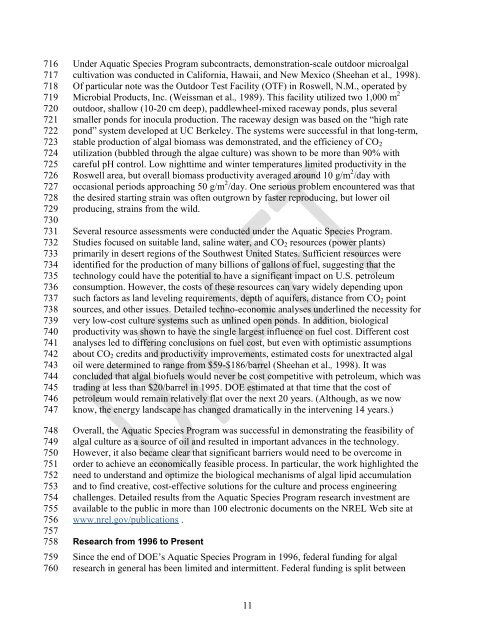Download the Algal Biofuels Roadmap draft document - Sandia
Download the Algal Biofuels Roadmap draft document - Sandia
Download the Algal Biofuels Roadmap draft document - Sandia
You also want an ePaper? Increase the reach of your titles
YUMPU automatically turns print PDFs into web optimized ePapers that Google loves.
716<br />
717<br />
718<br />
719<br />
720<br />
721<br />
722<br />
723<br />
724<br />
725<br />
726<br />
727<br />
728<br />
729<br />
730<br />
731<br />
732<br />
733<br />
734<br />
735<br />
736<br />
737<br />
738<br />
739<br />
740<br />
741<br />
742<br />
743<br />
744<br />
745<br />
746<br />
747<br />
748<br />
749<br />
750<br />
751<br />
752<br />
753<br />
754<br />
755<br />
756<br />
757<br />
758<br />
759<br />
760<br />
Under Aquatic Species Program subcontracts, demonstration-scale outdoor microalgal<br />
cultivation was conducted in California, Hawaii, and New Mexico (Sheehan et al., 1998).<br />
Of particular note was <strong>the</strong> Outdoor Test Facility (OTF) in Roswell, N.M., operated by<br />
Microbial Products, Inc. (Weissman et al., 1989). This facility utilized two 1,000 m 2<br />
outdoor, shallow (10-20 cm deep), paddlewheel-mixed raceway ponds, plus several<br />
smaller ponds for inocula production. The raceway design was based on <strong>the</strong> ―high rate<br />
pond‖ system developed at UC Berkeley. The systems were successful in that long-term,<br />
stable production of algal biomass was demonstrated, and <strong>the</strong> efficiency of CO2<br />
utilization (bubbled through <strong>the</strong> algae culture) was shown to be more than 90% with<br />
careful pH control. Low nighttime and winter temperatures limited productivity in <strong>the</strong><br />
Roswell area, but overall biomass productivity averaged around 10 g/m 2 /day with<br />
occasional periods approaching 50 g/m 2 /day. One serious problem encountered was that<br />
<strong>the</strong> desired starting strain was often outgrown by faster reproducing, but lower oil<br />
producing, strains from <strong>the</strong> wild.<br />
Several resource assessments were conducted under <strong>the</strong> Aquatic Species Program.<br />
Studies focused on suitable land, saline water, and CO2 resources (power plants)<br />
primarily in desert regions of <strong>the</strong> Southwest United States. Sufficient resources were<br />
identified for <strong>the</strong> production of many billions of gallons of fuel, suggesting that <strong>the</strong><br />
technology could have <strong>the</strong> potential to have a significant impact on U.S. petroleum<br />
consumption. However, <strong>the</strong> costs of <strong>the</strong>se resources can vary widely depending upon<br />
such factors as land leveling requirements, depth of aquifers, distance from CO2 point<br />
sources, and o<strong>the</strong>r issues. Detailed techno-economic analyses underlined <strong>the</strong> necessity for<br />
very low-cost culture systems such as unlined open ponds. In addition, biological<br />
productivity was shown to have <strong>the</strong> single largest influence on fuel cost. Different cost<br />
analyses led to differing conclusions on fuel cost, but even with optimistic assumptions<br />
about CO2 credits and productivity improvements, estimated costs for unextracted algal<br />
oil were determined to range from $59-$186/barrel (Sheehan et al., 1998). It was<br />
concluded that algal biofuels would never be cost competitive with petroleum, which was<br />
trading at less than $20/barrel in 1995. DOE estimated at that time that <strong>the</strong> cost of<br />
petroleum would remain relatively flat over <strong>the</strong> next 20 years. (Although, as we now<br />
know, <strong>the</strong> energy landscape has changed dramatically in <strong>the</strong> intervening 14 years.)<br />
Overall, <strong>the</strong> Aquatic Species Program was successful in demonstrating <strong>the</strong> feasibility of<br />
algal culture as a source of oil and resulted in important advances in <strong>the</strong> technology.<br />
However, it also became clear that significant barriers would need to be overcome in<br />
order to achieve an economically feasible process. In particular, <strong>the</strong> work highlighted <strong>the</strong><br />
need to understand and optimize <strong>the</strong> biological mechanisms of algal lipid accumulation<br />
and to find creative, cost-effective solutions for <strong>the</strong> culture and process engineering<br />
challenges. Detailed results from <strong>the</strong> Aquatic Species Program research investment are<br />
available to <strong>the</strong> public in more than 100 electronic <strong>document</strong>s on <strong>the</strong> NREL Web site at<br />
www.nrel.gov/publications .<br />
Research from 1996 to Present<br />
Since <strong>the</strong> end of DOE‘s Aquatic Species Program in 1996, federal funding for algal<br />
research in general has been limited and intermittent. Federal funding is split between<br />
11


